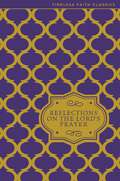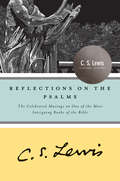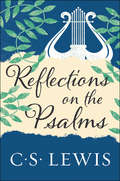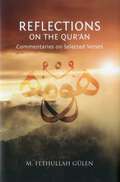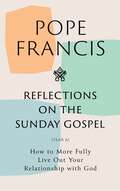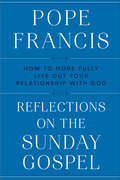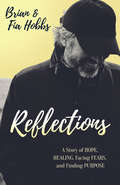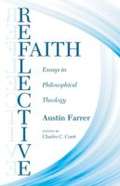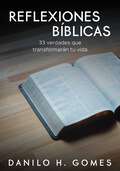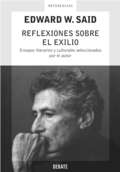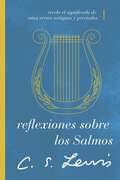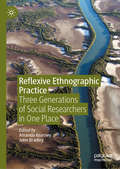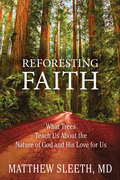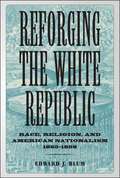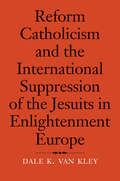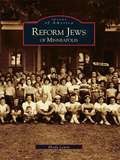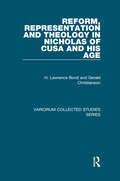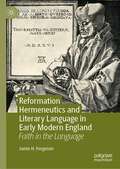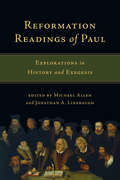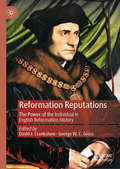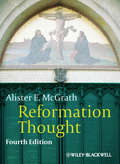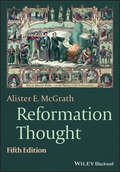- Table View
- List View
Reflections on the Lord's Prayer: Inspiring Thoughts on Jesus' Own Prayer (Timeless Faith Classics)
by Susan BrowerUpdated with a fresh look and feel, Reflections on the Lord&’s Prayer joins the Zondervan Gift Timeless Faith Classics line.Reflections on the Lord&’s Prayer will join Serenity and The Creeds as a beautiful new entry into the new Timeless Faith Classics line. Combining fresh, elegant designs with reflections specific to select classics, each beautiful volume will be a welcome addition to any bookshelf.Reflections on the Lord&’s Prayer presents the best-known prayer among Christians as the ultimate prayer model. From Martin Luther's reflection on why the prayer opens with 'Our Father . . . ' to the acknowledgment of God's '... power and glory forever,' readers will enjoy insights and thoughts culled from a variety of respected writers to enhance understanding of the prayer. Carefully chosen passages of Scripture help confirm and underscore the relevance of each phrase---and the prayer as a whole---in our daily lives.
Reflections on the Psalms
by C. S. LewisA christian book that represent an attempt to find the inner meaning and values of one limited part of the Bible (Psalms)
Reflections on the Psalms: The Pilgrim's Regress / Prayer: Letter To Malcolm / Reflections On The Psalms / Till We Have Faces / The Abolition Of Man
by C. S. LewisA repackaged edition of the revered author’s moving theological work in which he considers the most poetic portions from Scripture and what they tell us about God, the Bible, and faith.In this wise and enlightening book, C. S. Lewis—the great British writer, scholar, lay theologian, broadcaster, Christian apologist, and bestselling author of Mere Christianity, The Screwtape Letters, The Great Divorce, The Chronicles of Narnia, and many other beloved classics—examines the Psalms. As Lewis divines the meaning behind these timeless poetic verses, he makes clear their significance in our daily lives, and reminds us of their power to illuminate moments of grace.
Reflections on the Qur'an: Commentaries on Selected Verses
by M. Fethullah GülenThe Qur&’an is believed by Muslims to be the final word of God revealed to humanity through Prophet Muhammad speaking to all humans for all times. This nature of Islam&’s holy book brings along a continuous study of it so that its injunctions are reinterpreted according to constantly changing times and conditions of our world. This book presents such interpretations from a respected Muslim scholar who explains verses for the modern age. Gülen is well-informed of the classical exegetical discipline; nevertheless in this book he keeps his explanations short and to the point, not to tire away readers. The book does not cover all the verses of the Qur&’an, but selected ones, those relate most to the human existence on earth, life after death, and stories revealed in the holy book
Reflections on the Sunday Gospel (YEAR A): How to More Fully Live Out Your Relationship with God
by Pope FrancisWe live in an unprecedented time that has threatened to upend our daily rhythms, our work, our homes - even our faith. More than ever, we need books like Reflections on the Sunday Gospel to stir us to hope, to comfort, to peace. We need to remember what we live for and how good God is. These reflections - published in English for the first time, drawn both from homilies given by Pope Francis and readings from the Fathers of the Church, including Saint Augustine, Saint Jerome, and Saint Ambrose - do more than offer a way to enter into the liturgical year with weekly readings to enrich your devotional time. They offer Christ, and the power of his resurrection. They offer his words of assurance: 'I have said these things to you, that in me you may have peace. In the world you will have tribulation. But take heart; I have overcome the world'.Ultimately, as Pope Francis guides us through these timeless words, we will glean how even the giants of the faith needed God as much as we do, and how we can draw near to a good and faithful God no matter where we are or what season we're in.
Reflections on the Sunday Gospel: How to More Fully Live Out Your Relationship with God
by Pope FrancisPope Francis illuminates a new, vibrant way of experiencing the Gospel through moving, intimate, and deeply meditative reflections that encourage us to live fully with meaning, purpose, and strength.We live in an unprecedented time that has threatened to upend our daily rhythms, our work, our homes, even our faith. More than ever, we need books like Reflections on the Sunday Gospel to stir us to hope, to comfort, to peace. We need to remember what we live for and how good God is. These reflections—published in English for the first time, drawn both from homilies given by Pope Francis and readings from the Fathers of the Church, including Saint Augustine, Saint Jerome, and Saint Ambrose—do more than offer a way to enter into the liturgical year with weekly readings to enrich your devotional time. They offer Christ, and the power of His resurrection. They offer His words of assurance: &“I have said these things to you, that in me you may have peace. In the world you will have tribulation. But take heart; I have overcome the world&” (Jn 16:33, ESV).Ultimately, as Pope Francis guides us through these timeless words, we will glean how even the giants of the faith needed God as much as we do, and how we can draw near to a good and faithful God no matter where we are or what season we&’re in.
Reflections: A Story of Hope, Healing, Facing Fears, and Finding Purpose
by Brian Hobbs Fia HobbsReflections takes readers on an honest journey through dealing with fears, coming to term with illness, facing death, and acceptance.Reflections is a gripping story written from two perspectives: Brian Hobbs, a songwriter with a terminal cancer diagnosis with months to live, and Fia Hobbs, his caregiving wife as well as his therapist. They share with readers their journey through hope, despair, and finally to peace and acceptance. During Brian’s illness, he wrote down his thoughts and feelings in a blog that became a huge inspiration for people to let go of their own fears and to find purpose in their own lives. Reflections is a continuation of Brian’s blog and helps to inspire readers to make them realize what matters in life as they follow his last months.
Reflections: Notes On My Journey
by Cathy McNamara DalySince committing my life to Christ, I have, occasionally, become a secretary for the Holy Spirit. This collection comes out of that relationship and the various conversations we have shared at the highs, lows, and in-betweens of that walk.
Reflective Faith: Essays In Philosophical Theology
by Austin Farrer Charles ContiIn the foreword to this collection of essays, the noted British philosopher of religion John Hick aptly describes the style and tone to be found in Reflective Faith. <P><P> "Farrer asks . . . the right questions and thereby puts philosophical theology on the right road. This collection constitutes an introduction to Farrer's thought such as many have wished for; and it will be important also for those who are concerned to study Farrer's work as a whole." And that work, Hick adds, "is so far removed from the realm of unanalyzed slogans, vague metaphors, and all form of sloppiness and imprecision, that to read someone of Farrer's stature is to lose any taste for the lower levels of theological writing." <P><P> Reflective Faith spans Farrer's long career at Oxford, and includes essays taken from lectures, papers, and broadcast talks presented during those years. Originally written for select and usually small audiences, they display a warmth and spontaneity that enables readers to draw close to Farrer, and in so doing to appreciate his breadth of scholarship and wit. Here is traced the evolution of Farrer's thought from its early origins in scholastic theology to his eventual movement towards the "philosophy of action." Also included are study notes provided by the editor, and a bibliography of Farrer's published works.
Reflexiones Bíblicas: 33 verdades que transformarán tu vida
by Danilo H. GomesLa palabra de Dios es el combustible del cistiano. Infelizmente, una buena parte de los cristianos dedica mucho tiempo a las cosas banales del dia a dia y, como consecuencia, deja de lado las Sagradas Escrituras. Tienes noción de cuántas reflexiones edificantes nos puede proporcionar la Biblia? Innumerables. En este libro están reunidos 33 artículos que fueron escritos durante un tiempo de grandes reflexiones. Deja que Dios hable contigo durante el transcurso de cada página. Deja que Su amor y Su presencia llenen tu corazón.
Reflexiones sobre el exilio: Ensayos literarios y culturales seleccionados por el autor
by Edward W. SaidLa selección definitiva de los ensayos culturales y literarios de Edward W. Said realizada por el propio autor. Este libro reúne ensayos sobre temas culturales y literarios escritos por Edward W. Said a lo largo de tres décadas de intenso trabajo intelectual y político. Vistos en conjunto y con la perspectiva crítica que concede el tiempo, estos textos -seleccionados por el propio autor como compendio de su carrera humanista- nos ofrecen la oportunidad de contemplar la evolución y formación de un combativo profesor, un hombre de palabra y acción, así como el desarrollo de una vocación por el conocimiento del mundo llevada hasta sus últimas consecuencias. De sus reflexiones sobre la cultura popular, que le llevan a calificar a Tarzán de «exiliado permanente» o evocar la figura de la bailarina del vientre Tahia Carioca, al machismo y la tauromaquia de Hemingway, pasando por las diferencias que distinguen ciudades como Alejandría y El Cairo, o sus indispensables capítulos sobre música (Gould, Boulez, Wagner, Beethoven y Bach), el autor de Orientalismo expone en estos artículos su punto de vista inteligente y siempre contrario a la edificación de cánones literarios. Reseña:«El retrato de una vida intelectual ejemplar en la cual rigor y claridad se unen con coraje y compromiso [...] Esta es, con toda seguridad, una de las obras más importantes de la cultura y las humanidades que América ha producido en los últimos años.»Martha C. Nussbaum, The New York Times Book Review
Reflexiones sobre los Salmos: Revela el significado de estos versos antiguos y preciados
by C. S. LewisUna hermosa obra maestra teológica del venerado C. S. Lewis en la que considera las porciones más poéticas de las Escrituras y lo que nos dicen sobre Dios, la Biblia y la fe.En este acertado y esclarecedor libro, C. S. Lewis, el gran escritor británico, erudito, teólogo laico, locutor, apologista cristiano y autor bestseller de Mero cristianismo, Las cartas del diablo a su sobrino, El gran divorcio, Las crónicas de Narnia y muchos otros amados clásicos, examina los Salmos. A medida que Lewis revela el significado de estos versos poéticos intemporales, aclara su importancia en nuestra vida cotidiana y nos recuerda su poder para iluminar momentos de gracia.The Reflections on the PsalmsA beautiful masterpiece of the revered author&’s moving theological work in which he considers the most poetic portions from Scripture and what they tell us about God, the Bible, and faith.In this wise and enlightening book, C. S. Lewis—the great British writer, scholar, lay theologian, broadcaster, Christian apologist, and bestselling author of Mere Christianity, The Screwtape Letters, The Great Divorce, The Chronicles of Narnia, and many other beloved classics—examines the Psalms. As Lewis divines the meaning behind these timeless poetic verses, he makes clear their significance in our daily lives, and reminds us of their power to illuminate moments of grace.
Reflexive Ethnographic Practice: Three Generations of Social Researchers in One Place
by John Bradley Amanda KearneyPutting the anthropological imagination under the spotlight, this book represents the experience of three generations of researchers, each of whom have long collaborated with the same Indigenous community over the course of their careers. In the context of a remote Indigenous Australian community in northern Australia, these researchers—anthropologists, an archeologist, a literary scholar, and an artist—encounter reflexivity and ethnographic practice through deeply personal and professionally revealing accounts of anthropological consciousness, relational encounters, and knowledge sharing. In six discrete chapters, the authors reveal the complexities that run through these relationships, considering how any one of us builds knowledge, shares knowledge, how we encounter different and new knowledge, and how well we are positioned to understand the lived experiences of others, whilst making ourselves fully available to personal change. At its core, this anthology is a meditation on learning and friendship across cultures.
Reforesting Faith: What Trees Teach Us About the Nature of God and His Love for Us
by Matthew SleethThe Bible talks about trees more than any living creation other than people. Perhaps you've missed the forest...and the trees.In this groundbreaking walk through Scripture, former physician and carpenter Dr. Matthew Sleeth makes the convincing case why trees are essential to every Christian's understanding of God. Yet we've mostly missed how God has chosen to tell His story--and ours--through the lens of trees. There's a tree on the first page of Genesis and the last page of Revelation. The Bible refers to its wisdom as a Tree of Life (Proverbs 3:18). Every major Biblical character has a tree associated with them. Jesus himself says he is the true vine (John 15:1). A tree was used to kill Jesus--and a tree is the only thing the Messiah ever harmed. This is no accident. When we subtract trees from Scripture, we miss lessons of faith necessary for our growth. This is the rare book that connects those who love the Creator with creation, and those who love creation with the Creator. It offers inspirational yet practical ways to express our love for God--and our neighbors--by planting spiritual trees and physical trees in the world.Join Dr. Sleeth as he navigates the Bible's trail of trees to explore the wonders of life, death, and rebirth. You'll be amazed at how science is just beginning to catch up to the truths described in Scripture thousands of years ago. Once you discover the hidden language of trees, your walk through the woods--and through Scripture--will never be the same.
Reforging the White Republic
by Edward J. BlumDuring Reconstruction, former abolitionists in the North had a golden opportunity to pursue true racial justice and permanent reform in America. But why, after the sacrifice made by thousands of Civil War patriots to arrive at this juncture, did the moment slip away, leaving many whites throughout the North and South more racist than before? Edward J. Blum takes a fresh look at this question in Reforging the White Republic: Race, Religion, and American Nationalism, 1865-1898, where he focuses on the vital role that religion played in reunifying northern and southern whites into a racially segregated society. He tells the fascinating story of how northern Protestantism, once the catalyst for racial egalitarianism, promoted the image of a "white republic" that conflated whiteness, godliness, and nationalism. A blend of history and social science, Reforging the White Republic offers a surprising perspective on the forces of religion as well as nationalism and imperialism at a critical point in American history.
Reforging the White Republic: Race, Religion, and American Nationalism, 1865--1898 (Conflicting Worlds: New Dimensions of the American Civil War)
by John Stauffer Edward J. BlumDuring Reconstruction, former abolitionists in the North had a golden opportunity to pursue true racial justice and permanent reform in America. But after the sacrifice made by thousands of Union soldiers to arrive at this juncture, the moment soon slipped away, leaving many whites throughout the North and South more racist than before. Edward J. Blum takes a fresh look at the reasons for this failure in Reforging the White Republic, focusing on the vital role that religion played in reunifying northern and southern whites into a racially segregated society. A blend of history and social science, Reforging the White Republic offers a surprising perspective on the forces of religion as well as nationalism and imperialism at a critical point in American history.
Reform Catholicism and the International Suppression of the Jesuits in Enlightenment Europe
by Dale K. Van KleyAn investigation into the role of Reform Catholicism in the international suppression of the Jesuits in 1773†‹ The Jesuits devoted themselves to preaching the word of God, administering the sacraments, and spreading the faith by missions in both Europe and newly discovered lands abroad. But, in 1773, under intense pressure from the monarchs of Europe, the papacy suppressed the Society of Jesus, an act that reverberated from Europe to the Americas and Southeast Asia. In this scholarly history, Dale Van Kley argues that Reform Catholicism, not a secular Enlightenment, provided the justification for Catholic kings to suppress a society instituted by the papacy. Spanning the years from the mid†‘sixteenth century to the onset of the French Revolution, and the Jesuit presence from China to Brazil, this is the only single volume in English to make coherent sense of the series of expulsions that add up to what was arguably the most important religious event in Europe of the time, resulting in the secularization of tens of thousands of Jesuits.
Reform Jews of Minneapolis (Images of America)
by Rhoda LewinThe German Jews who began coming to Minneapolis in the 1850s quickly entered society as doctors, lawyers, professors, merchants, and leaders in clothing and cigar manufacturing. In 1878 they founded Shaarai Tov, now Temple Israel--one of the ten largest Reform congregations in the U.S. today. They also enjoyed a busy social and cultural life, and both husbands and wives involved themselves in social service and welfare organizations. Including historic and present-day photographs and tales of the community--schools, synagogues, organizations, and outdoor activities--this collection uncovers the challenges and triumphs of Reform Jews in Minneapolis.
Reform and Reformation: England 1509-1558
by G. R. EltonReform, not a dream but a rational prospect, had become the spirit of the Reformation England; it also provides the theme for this remarkable history of the reigns of Henry, Edward and Mary.
Reform, Representation and Theology in Nicholas of Cusa and His Age
by H. Lawrence Bond Gerald ChristiansonWhile most works on Nicholas of Cusa concentrate either on his early career as author of the monumental 'Catholic Concordance' or on his later career as writer of remarkable philosophical/theological works such as 'On Learned Ignorance' and 'The Vision of God', the essays included here attempt to address the whole Cusanus, sharing common contexts, issues and themes. Following chapters on the legacy of conciliarism and ecumenicity, the story begins with the Council of Basel for which Cusanus wrote 'The Catholic Concordance', but from which he broke away, raising issues of private conscience as well as the balance between papal authority and representative councils in the pursuit of reform. The story then turns to the 'matrix' between Constantinople and a new council in Ferrara when Cusanus received a ship-board gift from the 'Father of Lights' and began to write his great philosophical/theological treatises. When taken together the essays in this book not only form a cohesive whole, they also enlighten aspects often left in the shade, such as the enigmatic aspects of Cusanus' participation in the council, and his mystical theology that reveals a man of faith in search of certainty beyond the well-trod paths of philosophical reflection.
Reformation Hermeneutics and Literary Language in Early Modern England: Faith in the Language (Early Modern Literature in History)
by Jamie H. FergusonThe expressive and literary capacities of post-Reformation English were largely shaped in response to the Bible. Faith in the Language examines the convergence of biblical interpretation and English literature, from William Tyndale to John Donne, and argues that the groundwork for a newly authoritative literary tradition in early modern England is laid in the discourse of biblical hermeneutics. The period 1525-1611 witnessed a proliferation of English biblical versions, provoking a century-long debate about how and whether the Bible should be rendered in English. These public, indeed institutional accounts of biblical English changed the language: questions about the relation between Scripture and exegetical tradition that shaped post-Reformation hermeneutics bore strange fruit in secular literature that defined itself through varying forms of autonomy vis-a-vis prior tradition.
Reformation Readings of Paul: Explorations in History and Exegesis
by Michael AllenDid the Protestant Reformers understand Paul correctly? Has the church today been unduly influenced by Reformation-era misreadings of the Pauline epistles? These questions—especially as they pertain to Martin Luther's interpretation of the Pauline doctrine of justification—have been at the forefront of much discussion within biblical studies and theology in light of the New Perspective on Paul. But that leads to another question: Have we understood the Reformers correctly? With that in mind, these essays seek to enable a more careful reading of the Reformers' exegesis of Pauline texts. Each chapter pairs a Reformer with a Pauline letter and then brings together a historical theologian and a biblical scholar to examine these Reformation-era readings of Paul. In doing so, this volume seeks a better understanding of the Reformers and the true meaning of the biblical text.
Reformation Reputations: The Power of the Individual in English Reformation History
by David J. Crankshaw George W. C. GrossThis book highlights the pivotal roles of individuals in England’s complex sixteenth-century reformations. While many historians study broad themes, such as religious moderation, this volume is centred on the perspective that great changes are instigated not by themes, or ‘isms’, but rather by people – a point recently underlined in the 2017 quincentenary commemorations of Martin Luther’s protest in Germany. That sovereigns from Henry VIII to Elizabeth I largely drove religious policy in Tudor England is well known. Instead, the essays collected in this volume, inspired by the quincentenary and based upon original research, take a novel approach, emphasizing the agency of some of their most interesting subjects: Protestant and Roman Catholic, clerical and lay, men and women. With an introduction that establishes why the commemorative impulse was so powerful in this period and explores how reputations were constructed, perpetuated and manipulated, the authors of the nine succeeding chapters examine the reputations of three archbishops of Canterbury (Thomas Cranmer, Matthew Parker and John Whitgift), three pioneering bishops’ wives (Elizabeth Coverdale, Margaret Cranmer and Anne Hooper), two Roman Catholic martyrs (John Fisher and Thomas More), one evangelical martyr other than Cranmer (Anne Askew), two Jesuits (John Gerard and Robert Persons) and one author whose confessional identity remains contested (Anthony Munday). Partly biographical, though mainly historiographical, these essays offer refreshing new perspectives on why the selected figures are famed (or should be famed) and discuss what their reformation reputations tell us today.
Reformation Thought: An Introduction
by Alister E. McGrathReformation Thought, 4th edition offers an ideal introduction to the central ideas of the European reformations for students of theology and history. Written by the bestselling author and renowned theologian, Alister McGrath, this engaging guide is accessible to students with no prior knowledge of Christian theology. This new edition of a classic text has been updated throughout with the very latest scholarship Includes greater coverage of the Catholic reformation, the counter-reformation, and the impact of women on the reformation Explores the core ideas and issues of the reformation in terms that can be easily understood by those new to the field Student-friendly features include images, updated bibliographies, a glossary, and a chronology of political and historical ideas This latest edition retains all the features which made the previous editions so popular with readers, while McGrath's revisions have ensured it remains the essential student guide to the subject.
Reformation Thought: An Introduction
by Alister E. McGrathReformation Thought Praise for previous editions:“Theologically informed, lucid, supremely accessible: no wonder McGrath’s introduction to the Reformation has staying power!”—Denis R. Janz, Loyola University“Vigorous, brisk, and highly stimulating. The reader will be thoroughly engaged from the outset, and considerably enlightened at the end.”—Dr. John Platt, Oxford University“[McGrath] is one of the best scholars and teachers of the Reformation... Teachers will rejoice in this wonderfully useful book.”—Teaching HistoryReformation Thought: An Introduction is a clear, engaging, and accessible introduction to the European Reformation of the sixteenth century. Written for readers with little to no knowledge of Christian theology or history, this indispensable guide surveys the ideas of the prominent thought leaders of the period, as well as its many movements, including Lutheranism, Calvinism, Anabaptism, and the Catholic and English Reformations. The text offers readers a framework to interpret the events of the Reformation in full view of the intellectual landscape and socio-political issues that fueled its development.Based on Alister McGrath’s acclaimed lecture course at Oxford University, the fully updated fifth edition incorporates the latest academic research in historical theology. Revised and expanded chapters describe the cultural backdrop of the Reformation, discuss the Reformation’s background in late Renaissance humanism and medieval scholasticism, and distill the findings of recent scholarship, including work on the history of the Christian doctrine of justification. A wealth of pedagogical features—including illustrations, updated bibliographies, a glossary, a chronology of political and historical ideas, and several appendices—supplement McGrath’s clear explanations.Written by a world-renowned theologian, Reformation Thought: An Introduction, Fifth Edition upholds its reputation as the ideal resource for university and seminary courses on Reformation thought and the widespread change it inspired in Christian belief and practice.
